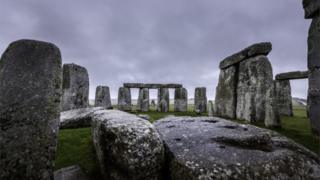Stonehenge: Neolithic monument found near sacred site
 Image copyright
Image copyright
PA wire
Archaeologists believe the find marks “a new chapter” in Stonehenge’s story
Archaeologists have discovered a ring of prehistoric shafts, dug thousands of years ago near Stonehenge.
Fieldwork has revealed evidence of a 1.2 mile (2km) wide circle of large shafts measuring more than 10m in diameter and 5m in depth.
They surround the ancient settlement of Durrington Walls, two miles (3km) from Stonehenge.
Tests suggest the ground works are Neolithic and were excavated more than 4,500 years ago.
Experts believe the 20 or more shafts may have served as a boundary to a sacred area connected to the henge.
A team of academics from the universities of St Andrews, Birmingham, Warwick, Glasgow and the University of Wales Trinity Saint David worked on the project
Image copyright
University of St Andrews/PA Wire
Yellow dots mark the location of the finds, with Durrington Wallls marked as the large brown circle and Stonehenge top left
Dr Richard Bates, from St Andrews’ School of Earth and Environmental Sciences, said: “Remote sensing and careful sampling is giving us an insight to the past that shows an even more complex society than we could ever imagine.
“Clearly sophisticated practices demonstrate that the people were so in tune with natural events to an extent that we can barely conceive in the modern world.”
Image copyright
University of St Andrews/PA Wire
The shafts surround the known location of Durrington Walls
His colleague Tim Kinnaird said sediments from the shafts that were tested “contain a rich and fascinating archive of previously unknown environmental information”.
He said studying the finds allowed archaeologists to “write detailed narratives of the Stonehenge landscape for the last 4,000 years”.
Dr Nick Snashall, National Trust archaeologist for the Stonehenge World Heritage Site, hailed the “astonishing discovery”.
He said: “As the place where the builders of Stonehenge lived and feasted Durrington Walls is key to unlocking the story of the wider Stonehenge landscape, and this astonishing discovery offers us new insights into the lives and beliefs of our Neolithic ancestors.
“The Hidden Landscapes team have combined cutting-edge, archaeological fieldwork with good old-fashioned detective work to reveal this extraordinary discovery and write a whole new chapter in the story of the Stonehenge landscape.”
The announcement of the discovery comes after the Summer Solstice, which took place online this year as the annual gathering at Stonehenge was cancelled due to coronavirus.
from WordPress https://ift.tt/30Z6vua



No comments